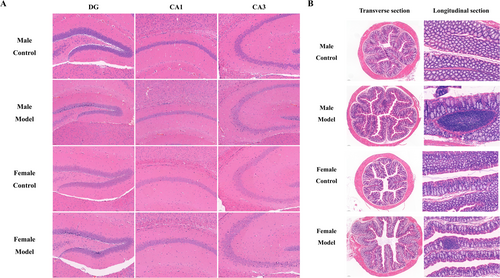Background
Stress is closely related to life, and it can also cause many mental disorders. However, there are significant sex differences in neuropsychiatric disorders associated with stress, particularly in depression, where the lifetime risk of depression in women is approximately twice that of men. However, the specific mechanism of this process has not been explained in detail.
Methods
Chronic restraint stress (CRS) + chronic and unpredictable mild stress (CUMS) was used to simulate social stress, and behavioral experiments, HE staining of rectal and hippocampal pathological sections, detection of depression-related biological indicators, analysis of intestinal flora diversity, and metabolomics analysis of hippocampal and intestinal contents were performed.
Results
The results showed that stress induced anxiety-like behavior in female mice and depression-like behavior in male mice. Sex differences in behavior may be related to monoamine neurotransmitters, hyperactivity of HPA axis, inflammatory factors, gut microbiota, and brain–gut metabolism. It is worth noting that stress caused opposite trends in DA (dopamine) levels, abundance of f-lactobaciliaceae, and levels of metabolites (1, 2-distearoyl-SN-glycero-3-phosphocholine) and PC(20:5(5Z,8Z,11Z,14Z,17Z)/20:1(11Z)) in male and female mice.
Conclusion
The difference in neurotransmitter levels, the disorder of gut microbiota, and the abnormal brain and gut metabolism may lead to the gender difference in stress behavior.

FIGURE 5
Effects of stress on (A) the hippocampal subregion and (B) rectal tissue in mice (H&E, n = 2; (A) bar = 50 nm; (B) Transverse section, bar = 100 nm; longitudinal section, bar = 50 nm).
The link below will guide you to the reading:
